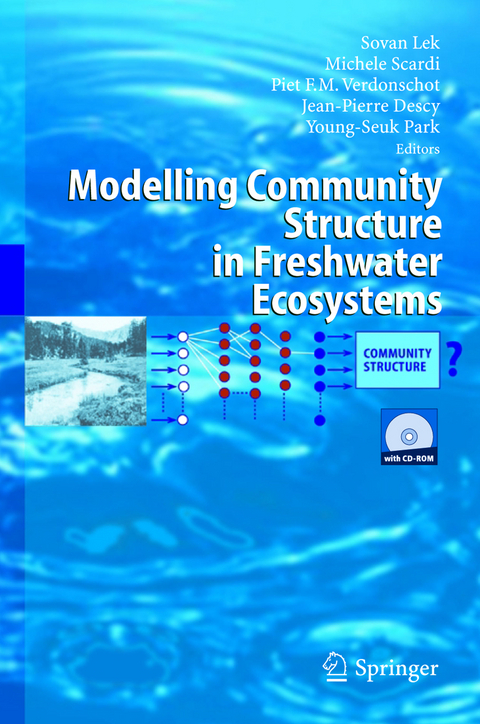
Modelling Community Structure in Freshwater Ecosystems
Springer Berlin (Verlag)
978-3-540-23940-6 (ISBN)
Fish community assemblages.- Patterning riverine fish assemblages using an unsupervised neural network.- Predicting fish assemblages in France and evaluating the influence of their environmental variables.- Fish diversity conservation and river restoration in southwest France: a review.- Modelling of freshwater fish and macro-crustacean assemblages for biological assessment in New Zealand.- A Comparison of various fitting techniques for predicting fish yield in Ubolratana reservoir (Thailand) from a time series data.- Patterning spatial variations in fish assemblage structures and diversity in the Pilica River system.- Optimisation of artificial neural networks for predicting fish assemblages in rivers.- General introduction.- Macroinvertebrate community assemblages.- Sensitivity and robustness of a stream model based on artificial neural networks for the simulation of different management scenarios.- A neural network approach to the prediction of benthic macroinvertebrate fauna composition in rivers.- Predicting Dutch macroinvertebrate species richness and functional feeding groups using five modelling techniques.- Comparison of clustering and ordination methods implemented to the full and partial data of benthic macroinvertebrate communities in streams and channels.- Prediction of macroinvertebrate diversity of freshwater bodies by adaptive learning algorithms.- Hierarchical patterning of benthic macroinvertebrate communities using unsupervised artificial neural networks.- Species spatial distribution and richness of stream insects in south-western France using artificial neural networks with potential use for biosurveillance.- Patterning community changes in benthic macroinvertebrates in a polluted stream by using artificial neural networks.- Patterning, predicting stream macroinvertebrate assemblages in Victoria (Australia) using artificial neural networks and genetic algorithms.- Using bioindicators to assess rivers in Europe: An overview.- Diatom and other algal assemblages.- Applying case-based reasoning to explore freshwater phytoplankton dynamics.- Modelling community changes of cyanobacteria in a flow regulated river (the lower Nakdong River, S. Korea) by means of a Self-Organizing Map (SOM).- Use of artificial intelligence (MIR-max) and chemical index to define type diatom assemblages in Rhône basin and Mediterranean region.- Classification of stream diatom communities using a self-organizing map.- Diatom typology of low-impacted conditions at a multi-regional scale: combined results of multivariate analyses and SOM.- Prediction with artificial neural networks of diatom assemblages in headwater streams of Luxembourg.- Use of neural network models to predict diatom assemblages in the Loire-Bretagne basin (France).- Review of modelling techniques.- Development of community assessment techniques.- Evaluation of relevant species in communities: development of structuring indices for the classification of communities using a self-organizing map.- Projection pursuit with robust indices for the analysis of ecological data.- A framework for computer-based data analysis and visualisation by pattern recognition.- A rule-based vs. a set-covering implementation of the knowledge system LIMPACT and its significance for maintenance and discovery of ecological knowledge.- Predicting macro-fauna community types from environmental variables by means of support vector machines.- User interface tool.- General conclusions and perspectives.
| Erscheint lt. Verlag | 14.2.2005 |
|---|---|
| Zusatzinfo | XII, 518 p. |
| Verlagsort | Berlin |
| Sprache | englisch |
| Maße | 155 x 235 mm |
| Gewicht | 880 g |
| Themenwelt | Naturwissenschaften ► Biologie ► Ökologie / Naturschutz |
| Naturwissenschaften ► Chemie ► Technische Chemie | |
| Technik ► Umwelttechnik / Biotechnologie | |
| Schlagworte | algorithms • aquatic communities • Aquatic sciences • biological • Ecology • ecosystem • ecosystem management • ecotoxicology • Environment • Fauna • fish • Functional Feeding Group • Gewässerschutz • Insects • Invertebrates • Optimization • Phytoplankton • Plankton • Species richness • Water Management |
| ISBN-10 | 3-540-23940-5 / 3540239405 |
| ISBN-13 | 978-3-540-23940-6 / 9783540239406 |
| Zustand | Neuware |
| Haben Sie eine Frage zum Produkt? |
aus dem Bereich


